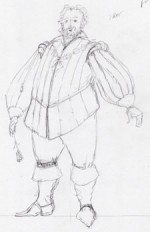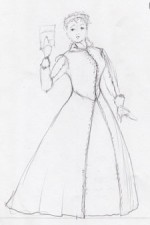Title
“Wherein is he good, but to taste sack and drink it? wherein neat and cleanly, but to carve a capon and eat it? wherein cunning, but in craft? wherein crafty, but in villany? wherein villanous, but in all things? wherein worthy, but in nothing?”
Body
So said Prince Hal in the second act of Shakespeare’s Henry IV, Part I. The object of his ridicule was Sir John Falstaff—a knight of mammoth proportions, known throughout the Windsor taverns for his indulgence, pomposity, cowardice, and of course, his remarkable girth. Yet Hal, awaiting his throne as King Henry V, at first found a certain allure in Falstaff’s hedonistic old age. The knight’s enthusiasm for life offered an attractive alternative to the pieties and properness demanded by the royal court. Similar qualities of Falstaff’s character must have intrigued Giuseppi Verdi some three centuries later as he began the preliminary sketches of what would become his final opera.
By the time of Falstaff’s composition, Verdi had enjoyed nearly half a century of widespread acclaim throughout Europe. From Nabucco (1842) to Otello (1887), he had demonstrated on repeated occasion his knack for communicating tragedy. In 1890, to most of the Italian music world’s shock, it was revealed publicly that Verdi had been collaborating once again with librettist Arrigo Boito—this time, on a comic opera. It was hard to believe that Verdi, who had recently explored a character of such complex significance as Shakespeare’s Othello, would bid adieu to the opera world with a work named after a knight known more for his rotundity than his profundity.
For conductor Keri-Lynn Wilson, who will be on the podium later this month for the Juilliard Opera Center’s performances of Falstaff, Verdi’s turn to opera buffa was a testament to his jovial spirit and optimistic world-view. “It’s mind-boggling, what was going on in his head, feeling like he could look back at his life and make it into a nice bright laugh—a chuckle at life,” Wilson said.
This production will mark the J.O.C. debuts of both Wilson and director Stephen Wadsworth, who have shaped their conceptions of Falstaff around the talent they were given to work with.
“It’s all in the casting, and from the casting,” Wadsworth remarked in a recent interview. “There are qualities these actors have as people and as artists that have expanded my notions of what is possible for the characters and situations of the piece.”
Wadsworth must have been drawing from a deep pool of talent in casting Falstaff, in which the dynamics of the ensemble are crucial to the success of the farce. As Boito drafted the libretto, he drew liberally from plot elements of The Merry Wives of Windsor, where the unfolding matrix of human relationships and interaction contributes fully to the comedy. Falstaff, that plump playboy, can’t help but see himself as one of England’s most charming and worthy bachelors—so much so that he composed a pair of audacious (albeit identical) love letters to two of Windsor’s more well-to-do brides, Alice Ford and Meg Page, as part of a grander money-making scheme. The women, not so easily duped, plot their revenge as part of a larger quartet of ladies, after whom Shakespeare’s play is named. Amidst the scheming, other subplots emerge and a number of characters and relationships are highlighted, as Verdi and Boito weave Shakespearean elements with their own original contributions to produce a unique, unified comedy.
“Falstaff is a conductor’s dream; we’re all in awe,” Wilson said. “There’s so much in performance in terms of the intricacies of the subtleties Verdi has taken from Shakespeare.”
While Falstaff’s plot is more or less based on The Merry Wives of Windsor, Verdi and Boito enrich the title character by drawing from the two other Shakespeare plays in which he appears, Henry IV, Parts I and II. Honor and loyalty are still familiar virtues to Falstaff in this pair of histories, although he appropriates them in his own idiosyncratic (and often dishonorable) ways. The corpulent knight represents a consistent presence in Prince Hal’s personal transformation. As Hal gradually turns aside from his life of consumption and promiscuity to assume the proper conduct and lifestyle of a king, he leaves Falstaff behind, ultimately rejecting him once absorbed in the power of his throne.
“I can definitely connect with that sense of betrayal and disappointment,” said baritone Nicholas Pallesen, who plays the title role in J.O.C.’s production, drawing his interpretation from the Falstaff of Henry IV. “If you bring that element to Verdi’s Falstaff, I think it makes him so much more of an interesting person, and it makes you understand more what he does in the opera. I want people to see Falstaff as a real human being that they can connect to in some way.”
Falstaff, then, can be interpreted as a symbol for the constancy of humanity, despite his rather backwards morality. Ironically, he proves honorable at least to his own lack of honor.
“He has been through a lot and is questioning the value of his life as it has taken shape,” Wadsworth observes. “So we are asking what he is really doing or thinking when he writes these identical love letters to two affluent women in town; what is he hoping for? It seems to me that he hopes fervently for some restoration of honor lost, for some restoration of dignity, for a chance to be seen as a viable man once again, and not just a fat pub-crawler.”
Practically speaking, Falstaff is a complex and difficult opera to produce, but the obstacles only add to the rewards. The work, known for its brilliant interplay between Verdi’s innovative orchestration and Boito’s clever weavings of text, places considerable demands on the interaction between those onstage and those in the pit. The challenges facing the students aren’t unfamiliar to Wilson, who received three degrees from Juilliard in both flute and conducting. “It’s making it into theater that’s a challenge,” she says. “Once the orchestra can get beyond the technicalities, they can find the lightness, the energy, breathing—maximizing at all times every single note and word.”
For Pallesen, the challenges are both technical and physical. “Falstaff is a really big, big sing. Vocal pacing is a big factor when you’re doing the role. But Falstaff is also a really physical role—especially inside a fat suit, under the stage lights. You sweat a ton, you get exhausted, you run out of breath faster ... I will probably lose 20 pounds doing this opera.”






